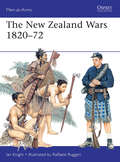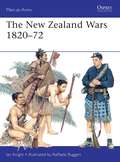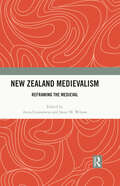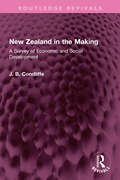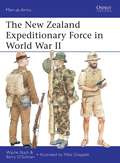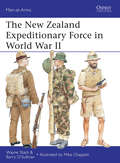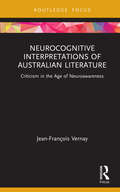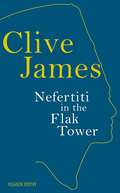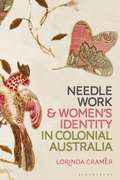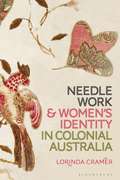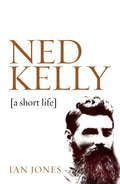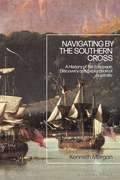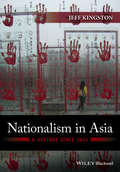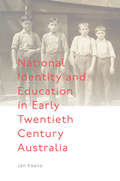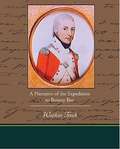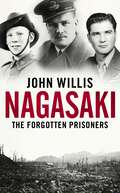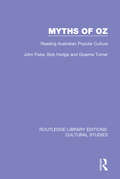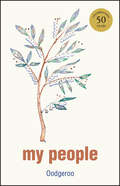- Table View
- List View
The New Zealand Wars 1820–72 (Men-at-Arms #487)
by Ian Knight Mr Raffaele RuggeriBetween 1845 and 1872, various groups of Maori were involved in a series of wars of resistance against British settlers. The Maori had a fierce and long-established warrior tradition and subduing them took a lengthy British Army commitment, only surpassed in the Victorian period by that on the North-West Frontier of India. Warfare had been endemic in pre-colonial New Zealand and Maori groups maintained fortified villages or pas. The small early British coastal settlements were tolerated, and in the 1820s a chief named Hongi Hika travelled to Britain with a missionary and returned laden with gifts. He promptly exchanged these for muskets, and began an aggressive 15-year expansion. By the 1860s many Maori had acquired firearms and had perfected their bush-warfare tactics. In the last phase of the wars a religious movement, Pai Maarire ('Hau Hau'), inspired remarkable guerrilla leaders such as Te Kooti Arikirangi to renewed resistance. This final phase saw a reduction in British Army forces. European victory was not total, but led to a negotiated peace that preserved some of the Maori people's territories and freedoms.
The New Zealand Wars 1820–72 (Men-at-Arms)
by Raffaele Ruggeri Ian KnightBetween 1845 and 1872, various groups of Maori were involved in a series of wars of resistance against British settlers. The Maori had a fierce and long-established warrior tradition and subduing them took a lengthy British Army commitment, only surpassed in the Victorian period by that on the North-West Frontier of India. Warfare had been endemic in pre-colonial New Zealand and Maori groups maintained fortified villages or pas. The small early British coastal settlements were tolerated, and in the 1820s a chief named Hongi Hika travelled to Britain with a missionary and returned laden with gifts. He promptly exchanged these for muskets, and began an aggressive 15-year expansion. By the 1860s many Maori had acquired firearms and had perfected their bush-warfare tactics. In the last phase of the wars a religious movement, Pai Maarire ('Hau Hau'), inspired remarkable guerrilla leaders such as Te Kooti Arikirangi to renewed resistance. This final phase saw a reduction in British Army forces. European victory was not total, but led to a negotiated peace that preserved some of the Maori people's territories and freedoms.
New Zealand Medievalism: Reframing the Medieval
by Anna Czarnowus Janet M. WilsonThis volume maps the phenomenon of medievalism in Aotearoa, initially as an import by the early white settler society, and as a form of nation building that would reinforce Britishness and ancestral belonging. This colonial narrative underpins the volume’s focus on the imperial relationship in chapters on the academic study of the Middle Ages, on medievalism in film and music, in manuscript and book collections, and colonial stained glass and architecture. Through the alternative 21st-century frameworks of a global Middle Ages and Aotearoa’s bicultural nationalism, the volume also introduces Maori understandings of the ancestral past that parallel the European epoch and, at the opposite end of the spectrum, the phenomenon of global right-wing medievalism, as evidenced in the Alt-right extremism underpinning the Christchurch mosque attack of 2019.The 11 chapters trace the transcultural moves and networks that comprise the shift from the 20th-century study of the Middle Ages as an historical period to manifestations of medievalism as the reception and interpretation of the medieval past in postmedieval times. Collectively these are viewed as indications of the changing public perception about the meaning and practice of the European heritage from the colonial to contemporary era.The volume will appeal to educationists, scholars, and students interested in the academic history of the Middle Ages in New Zealand; enthusiasts of film, music, and performance of the medieval; members of the public interested in Aotearoa’s history and popular culture; and all who enjoy the colourful reinventions of medievalism.
New Zealand Medievalism: Reframing the Medieval
This volume maps the phenomenon of medievalism in Aotearoa, initially as an import by the early white settler society, and as a form of nation building that would reinforce Britishness and ancestral belonging. This colonial narrative underpins the volume’s focus on the imperial relationship in chapters on the academic study of the Middle Ages, on medievalism in film and music, in manuscript and book collections, and colonial stained glass and architecture. Through the alternative 21st-century frameworks of a global Middle Ages and Aotearoa’s bicultural nationalism, the volume also introduces Maori understandings of the ancestral past that parallel the European epoch and, at the opposite end of the spectrum, the phenomenon of global right-wing medievalism, as evidenced in the Alt-right extremism underpinning the Christchurch mosque attack of 2019.The 11 chapters trace the transcultural moves and networks that comprise the shift from the 20th-century study of the Middle Ages as an historical period to manifestations of medievalism as the reception and interpretation of the medieval past in postmedieval times. Collectively these are viewed as indications of the changing public perception about the meaning and practice of the European heritage from the colonial to contemporary era.The volume will appeal to educationists, scholars, and students interested in the academic history of the Middle Ages in New Zealand; enthusiasts of film, music, and performance of the medieval; members of the public interested in Aotearoa’s history and popular culture; and all who enjoy the colourful reinventions of medievalism.
New Zealand in the Making: A Survey of Economic and Social Development (Routledge Revivals)
by J. B. CondliffeFirst published in 1930, New Zealand in the Making is an economic history of the democratic experiments in New Zealand. The geography, population, government ownership of public utilities, compulsory arbitration, pensions and all other factors have been covered in detail. The book will be of interest to anyone keen on learning about New Zealand as well as to students of economy, history, agriculture, and government.
New Zealand in the Making: A Survey of Economic and Social Development (Routledge Revivals)
by J. B. CondliffeFirst published in 1930, New Zealand in the Making is an economic history of the democratic experiments in New Zealand. The geography, population, government ownership of public utilities, compulsory arbitration, pensions and all other factors have been covered in detail. The book will be of interest to anyone keen on learning about New Zealand as well as to students of economy, history, agriculture, and government.
The New Zealand Expeditionary Force in World War II (Men-at-Arms)
by Mike Chappell Wayne Stack Barry O’SullivanIn 1939 more than 140,000 New Zealanders enlisted to fight overseas during World War II. Of these, 104,000 served in the Second New Zealand Expeditionary Force. Initially thrown into the doomed campaign to halt the German blitzkrieg on Greece and Crete (1941), the division was rebuilt under the leadership of MajGen Sir Bernard Freyberg, and became the elite corps within Montgomery's Eighth Army in the desert. After playing a vital role in the victory at El Alamein (1942) the 'Kiwis' were the vanguard of the pursuit to Tunisia. In 1943–45 the division was heavily engaged in the Italian mountains, especially at Cassino (1944); it ended the war in Trieste. Meanwhile, a smaller NZ force supported US forces against the Japanese in the Solomons and New Guinea (1942–44). Fully illustrated with specially commissioned colour plates, this is the story of the Second New Zealand Expeditionary Force's vital contribution to Allied victory in World War II.
The New Zealand Expeditionary Force in World War II (Men-at-Arms #486)
by Mike Chappell Wayne Stack Barry O’SullivanIn 1939 more than 140,000 New Zealanders enlisted to fight overseas during World War II. Of these, 104,000 served in the Second New Zealand Expeditionary Force. Initially thrown into the doomed campaign to halt the German blitzkrieg on Greece and Crete (1941), the division was rebuilt under the leadership of MajGen Sir Bernard Freyberg, and became the elite corps within Montgomery's Eighth Army in the desert. After playing a vital role in the victory at El Alamein (1942) the 'Kiwis' were the vanguard of the pursuit to Tunisia. In 1943–45 the division was heavily engaged in the Italian mountains, especially at Cassino (1944); it ended the war in Trieste. Meanwhile, a smaller NZ force supported US forces against the Japanese in the Solomons and New Guinea (1942–44). Fully illustrated with specially commissioned colour plates, this is the story of the Second New Zealand Expeditionary Force's vital contribution to Allied victory in World War II.
Neurocognitive Interpretations of Australian Literature: Criticism in the Age of Neuroawareness (Routledge Focus on Literature)
by Jean-François VernayThis unique book on neurocognitive interpretations of Australian literature covers a wide range of analyses by discussing Australian Literary Studies, Aboriginal literary texts, women writers, ethnic writing, bestsellers, neurodivergence fiction, emerging as well as high- profile writers, literary hoaxes and controversies, book culture, and LGBTIQA+ authors, to name a few. It eclectically brings together a wide gamut of cognitive concepts and literary genres at the intersection of Australian literary studies and cognitive literary studies in the first single-author volume of its kind. It takes Australian Literary Studies into the age of neuroawareness and provides new pathways in contemporary criticism.
Neurocognitive Interpretations of Australian Literature: Criticism in the Age of Neuroawareness (Routledge Focus on Literature)
by Jean-François VernayThis unique book on neurocognitive interpretations of Australian literature covers a wide range of analyses by discussing Australian Literary Studies, Aboriginal literary texts, women writers, ethnic writing, bestsellers, neurodivergence fiction, emerging as well as high- profile writers, literary hoaxes and controversies, book culture, and LGBTIQA+ authors, to name a few. It eclectically brings together a wide gamut of cognitive concepts and literary genres at the intersection of Australian literary studies and cognitive literary studies in the first single-author volume of its kind. It takes Australian Literary Studies into the age of neuroawareness and provides new pathways in contemporary criticism.
Nefertiti in the Flak Tower: Poems
by Clive JamesClive James’ power as a poet has increased year by year, and there has been no stronger evidence for this than Nefertiti in the Flak Tower. Here, his polymathic learning and technical virtuosity are worn more lightly than ever; the effect is merely to produce a deep sense of trust into which the reader gratefully sinks, knowing they are in the presence of a master. The most obvious token of that mastery is the book’s breathtaking range of theme: there are moving elegies, a meditation on the later Yeats, a Hollywood Iliad, odes to rare orchids, wartime typewriters and sharks – as well as a poem on the fate of Queen Nefertiti in Nazi Germany. But despite the dizzying variety, James’ poetic intention becomes increasingly clear: what marks this collection out is his intensified concentration on the individual poem as self-contained universe. Poetry is a practice he compares (in ‘Numismatics’) to striking new coin; and Nefertiti in the Flak Tower is a treasure-chest of one-off marvels, with each poem a twin-sided, perfect human balance of the unashamedly joyous and the deadly serious, ‘whose play of light pays tribute to the dark’.
Needlework and Women’s Identity in Colonial Australia
by Lorinda CramerIn gold-rush Australia, social identity was in flux: gold promised access to fashionable new clothes, a grand home, and the goods to furnish it, but could not buy gentility. Needlework and Women's Identity in Colonial Australia explores how the wives, mothers, sisters, and daughters who migrated to the newly formed colony of Victoria used their needle skills as a powerful claim to social standing.Focusing on one of women's most common daily tasks, the book examines how needlework's practice and products were vital in the contest for social position in the turmoil of the first two decades of the Victorian rush from 1851. Placing women firmly at the center of colonial history, it explores how the needle became a tool for stitching together identity. From decorative needlework to household making and mending, women's sewing was a vehicle for establishing, asserting, and maintaining social status.Interdisciplinary in scope, Needlework and Women's Identity in Colonial Australia draws on material culture, written primary sources, and pictorial evidence, to create a rich portrait of the objects and manners that defined genteel goldfields living. Giving voice to women's experiences and positioning them as key players in the fabric of gold-rush society, this volume offers a fresh critical perspective on gender and textile history.
Needlework and Women’s Identity in Colonial Australia
by Lorinda CramerIn gold-rush Australia, social identity was in flux: gold promised access to fashionable new clothes, a grand home, and the goods to furnish it, but could not buy gentility. Needlework and Women's Identity in Colonial Australia explores how the wives, mothers, sisters, and daughters who migrated to the newly formed colony of Victoria used their needle skills as a powerful claim to social standing.Focusing on one of women's most common daily tasks, the book examines how needlework's practice and products were vital in the contest for social position in the turmoil of the first two decades of the Victorian rush from 1851. Placing women firmly at the center of colonial history, it explores how the needle became a tool for stitching together identity. From decorative needlework to household making and mending, women's sewing was a vehicle for establishing, asserting, and maintaining social status.Interdisciplinary in scope, Needlework and Women's Identity in Colonial Australia draws on material culture, written primary sources, and pictorial evidence, to create a rich portrait of the objects and manners that defined genteel goldfields living. Giving voice to women's experiences and positioning them as key players in the fabric of gold-rush society, this volume offers a fresh critical perspective on gender and textile history.
Ned Kelly: A short life
by Ian Jones'the best Kelly biography by a country mile' - The AustralianThe definitive biography of Ned Kelly - and a superb description of his times. A bestseller since it was first published, Ned Kelly: A Short Life is acknowledged as being the definitive biography. Ian Jones combines years of research into all the records of the era and exhaustive interviews with living descendants of those involved, to present a vivid and gripping account of one of Australia's most iconic figures. ‘It will probably stand as the definitive account of Kelly’s life and its meaning…a work of prodigious scholarship, vivid reportage and sharp analysis…the most detailed portrait of the outlaw ever written’ - Rod Moran, West Australian‘the definitive biographical work’ - Dr John McQuilton, author of The Kelly Outbreak
Navigating by the Southern Cross: A History of the European Discovery and Exploration of Australia
by Kenneth MorganIn this comprehensive study, Kenneth Morgan provides an authoritative account of European exploration and discovery in Australia. The book presents a detailed chronological overview of European interests in the Australian continent, from initial speculations about the 'Great Southern Land' to the major hydrographic expeditions of the 19th century. In particular, he analyses the early crossings of the Dutch in the 17th century, the exploits of English 'buccaneer adventurer' William Dampier, the famous voyages of James Cook and Matthew Flinders, and the little-known French annexation of Australia in 1772. Introducing new findings and drawing on the latest in historiographical research, this book situates developments in navigation, nautical astronomy and cartography within the broader contexts of imperial, colonial, and maritime history.
Navigating by the Southern Cross: A History of the European Discovery and Exploration of Australia
by Kenneth MorganIn this comprehensive study, Kenneth Morgan provides an authoritative account of European exploration and discovery in Australia. The book presents a detailed chronological overview of European interests in the Australian continent, from initial speculations about the 'Great Southern Land' to the major hydrographic expeditions of the 19th century. In particular, he analyses the early crossings of the Dutch in the 17th century, the exploits of English 'buccaneer adventurer' William Dampier, the famous voyages of James Cook and Matthew Flinders, and the little-known French annexation of Australia in 1772. Introducing new findings and drawing on the latest in historiographical research, this book situates developments in navigation, nautical astronomy and cartography within the broader contexts of imperial, colonial, and maritime history.
Nationalism in Asia: A History Since 1945
by Jeff KingstonUsing a comparative, interdisciplinary approach, Nationalism in Asia analyzes currents of nationalism in five contemporary Asian societies: China, India, Indonesia, Japan, and South Korea. Explores the ways in which nationalism is expressed, embraced, challenged, and resisted in contemporary China, India, Indonesia, Japan, and South Korea using a comparative, interdisciplinary approach Provides an important trans-national and trans-regional analysis by looking at five countries that span Northeast, Southeast, and South Asia Features comparative analysis of identity politics, democracy, economic policy, nation branding, sports, shared trauma, memory and culture wars, territorial disputes, national security and minorities Offers an accessible, thematic narrative written for non-specialists, including a detailed and up-to-date bibliography Gives readers an in-depth understanding of the ramifications of nationalism in these countries for the future of Asia
Nationalism in Asia: A History Since 1945
by Jeff KingstonUsing a comparative, interdisciplinary approach, Nationalism in Asia analyzes currents of nationalism in five contemporary Asian societies: China, India, Indonesia, Japan, and South Korea. Explores the ways in which nationalism is expressed, embraced, challenged, and resisted in contemporary China, India, Indonesia, Japan, and South Korea using a comparative, interdisciplinary approach Provides an important trans-national and trans-regional analysis by looking at five countries that span Northeast, Southeast, and South Asia Features comparative analysis of identity politics, democracy, economic policy, nation branding, sports, shared trauma, memory and culture wars, territorial disputes, national security and minorities Offers an accessible, thematic narrative written for non-specialists, including a detailed and up-to-date bibliography Gives readers an in-depth understanding of the ramifications of nationalism in these countries for the future of Asia
National Identity and Education in Early Twentieth Century Australia
by Jan KeaneThis fascinating book explores how curriculum content in education was used to cultivate a sense of Australian national identity during the first two decades of the twentieth century. Providing a comprehensive picture of the entire reading curriculum in Victorian government schools over a period of almost two decades, the author demonstrates that, contrary to received wisdom, the Department of Education made every effort to integrate children of different backgrounds. Using three dimensions frequently cited in national identity theory – landscape, history, and mythology – readers are shown how material was chosen specifically to engage young white settler children and to help them overcome their sense of Australia as the ‘other’. National Identity and Education in Early Twentieth Century Australia not only brings about a clearer understanding of how Australia came to be ‘Australian’ in character, it establishes how curriculum content may be brought into the service of nation-building across the globe.
National Identity and Education in Early Twentieth Century Australia
by Jan KeaneThis fascinating book explores how curriculum content in education was used to cultivate a sense of Australian national identity during the first two decades of the twentieth century. Providing a comprehensive picture of the entire reading curriculum in Victorian government schools over a period of almost two decades, the author demonstrates that, contrary to received wisdom, the Department of Education made every effort to integrate children of different backgrounds. Using three dimensions frequently cited in national identity theory – landscape, history, and mythology – readers are shown how material was chosen specifically to engage young white settler children and to help them overcome their sense of Australia as the ‘other’. National Identity and Education in Early Twentieth Century Australia not only brings about a clearer understanding of how Australia came to be ‘Australian’ in character, it establishes how curriculum content may be brought into the service of nation-building across the globe.
Nagasaki: The Forgotten Prisoners
by John WillisThis is one of the most remarkable untold stories of the Second World war. At 11.02 am on an August morning in 1945 America dropped the world's most powerful atomic bomb on the Japanese port city of Nagasaki. The most European city in Japan was flattened to the ground 'as if it had been swept aside by a broom'. More than 70,000 Japanese were killed. At the time, hundreds of Allied prisoners of war were working close to the bomb's detonation point, as forced labourers in the shipyards and foundries of Nagasaki.These men, from the Dales of Yorkshire and the dusty outback of Australia, from the fields of Holland and the remote towns of Texas, had already endured an extraordinary lottery of life and death that had changed their lives forever. They had lived through nearly four years of malnutrition, disease, and brutality. Now their prison home was the target of America's second atomic bomb.In one of the greatest survival stories of the Second World War, we trace their astonishing experiences back to bloody battles in the Malayan jungle, before the dramatic fall of Fortress Singapore, the mighty symbol of the British Empire. This abject capitulation was followed by surrender in Java and elsewhere in the East, condemning the captives to years of cruel imprisonment by the Japanese. Their lives grew evermore perilous when thousands of prisoners were shipped off to build the infamous Thai-Burma Railway, including the Bridge on the River Kwai. If that was not harsh enough, POWs were then transported to Japan in the overcrowded holds of what were called hell ships. These rusty buckets were regularly sunk by Allied submarines, and thousands of prisoners lived through unimaginable horror, adrift on the ocean for days. Some still had to endure the final supreme test, the world's second atomic bomb.The prisoners in Nagasaki were eyewitnesses to one of the most significant events in modern history but writing notes or diaries in a Japanese prison camp was dangerous. To avoid detection, one Allied prisoner buried his notes in the grave of a fellow POW to be reclaimed after the war, another wrote his diary in Irish. Now, using unpublished and rarely seen notes, interviews, and memoirs, this unique book weaves together a powerful chorus of voices to paint a vivid picture of defeat, endurance, and survival against astonishing odds.
Myths of Oz: Reading Australian Popular Culture (Routledge Library Editions: Cultural Studies)
by John Fiske Bob Hodge Graeme TurnerThis book, first published in 1987, sets out to examine and extend our understanding of Australian popular culture, and to counter the long-established, traditional criticism bewailing its lack. The authors argue that the 'knocker's' view started from an elitist viewpoint, yearning for Australia to aspire to a European culture in art, music, literature and other traditional cultural fields. They argue however that there are other definitions of culture that are more populist, more comprehensive, and which represent a vitality and dynamism which is a true reflection of the lives and aspirations of Australians. Myths of Oz offers no comprehensive definition of Australian culture, but rather a way of interpreting its various aspects. The barbeque or the pub, an expedition to the shops or a day at the beach, the home, the workplace or the job queue; all these intrinsic parts of Australian life are examined and conclusions drawn as to how they shape or are shaped by what we call popular culture. The authors look too at monuments and symbols, from Ayers Rock to the Sydney Opera House, which both shape and reflect Australian culture, while a chapter on the Australian accent shows how language and terminology play a powerful role in establishing cultural standpoints. A particular strength of this book is that while delivering a provocative and stimulating series of viewpoints on popular culture, it also makes use of current academic tools and methodology to ensure that we gain new insights into the meanings and pleasures we derive from our everyday experiences.
Myths of Oz: Reading Australian Popular Culture (Routledge Library Editions: Cultural Studies)
by John Fiske Bob Hodge Graeme TurnerThis book, first published in 1987, sets out to examine and extend our understanding of Australian popular culture, and to counter the long-established, traditional criticism bewailing its lack. The authors argue that the 'knocker's' view started from an elitist viewpoint, yearning for Australia to aspire to a European culture in art, music, literature and other traditional cultural fields. They argue however that there are other definitions of culture that are more populist, more comprehensive, and which represent a vitality and dynamism which is a true reflection of the lives and aspirations of Australians. Myths of Oz offers no comprehensive definition of Australian culture, but rather a way of interpreting its various aspects. The barbeque or the pub, an expedition to the shops or a day at the beach, the home, the workplace or the job queue; all these intrinsic parts of Australian life are examined and conclusions drawn as to how they shape or are shaped by what we call popular culture. The authors look too at monuments and symbols, from Ayers Rock to the Sydney Opera House, which both shape and reflect Australian culture, while a chapter on the Australian accent shows how language and terminology play a powerful role in establishing cultural standpoints. A particular strength of this book is that while delivering a provocative and stimulating series of viewpoints on popular culture, it also makes use of current academic tools and methodology to ensure that we gain new insights into the meanings and pleasures we derive from our everyday experiences.
My People
by Noonuccal OodgerooImmerse yourself in the poetry of one of Australia’s foremost Indigenous artists My People is a compilation of the poetry of Oodgeroo, of the tribe Noonuccal, Custodian of the land Minjerribah. This collection of captivating poetry detailing the struggle of Australia’s Indigenous peoples is more relevant today than ever before. While she passed away in 1993, Oodgeroo remains one of Australia’s most influential Aboriginal poets. Her poetry leaves little room to argue why that shouldn’t be the case. Razor-sharp and incisive, while simultaneously haunting and beautiful, Oodgeroo’s poems will enchant both young and old alike. My People is a bewitching collection of Oodgeroo’s poems that belongs on the bookshelves of every art lover and anyone with an appreciation of the written word.
